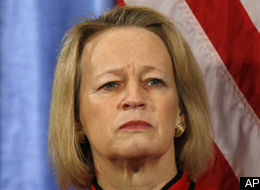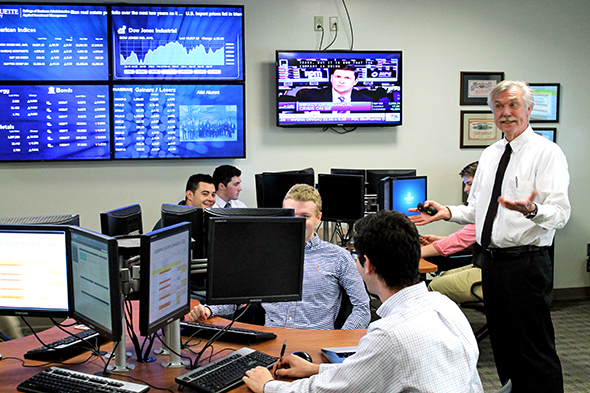
May 14 (Bloomberg) -- U.S. regulators may impose the same price reporting and transparency requirements on over-the- counter derivatives that reduced bank profits by almost half in the corporate bond market when the Trace system was adopted seven years ago.
“I think it’s something we’ll look at very closely as a potential model,” Securities and Exchange Chairwoman Mary Schapiro said yesterday at a news conference in Washington, in which regulators laid out potential structural changes to improve policing of the $684 trillion OTC derivatives market.
Trace, the bond-price reporting system of the Financial Industry Regulatory Authority, gives anyone with an Internet connection access to trading data for corporate bonds. The system, in full operation since February 2005, reduced the difference in prices that banks charge to buy and sell bonds by almost half.
Treasury Secretary Timothy Geithner, Schapiro and Michael Dunn, the acting chairman of the Commodity Futures Trading Commission, called for increased oversight of over-the-counter derivatives to reduce risk to the financial system. Lax regulation contributed to the failures last year of Lehman Brothers Holdings Inc. and American International Group Inc., leading to the seizure of credit markets and causing more than $1.4 trillion in writedowns amid the worst financial crisis since the Great Depression.
‘Accept the Reality’
“Dealers have to accept the reality that this business -- where margins were compressing already -- is getting less profitable,” said Stephen Bruel, research director for securities and capital markets for Tower Group, a research and advisory firm in Needham, Massachusetts. “A lot of the action you’ll see is to contain the size and scope and profitability of this market.”
The bid-ask spread on investment-grade corporate bonds was about seven basis points before Trace was implemented and about four basis points immediately after, according to a study by Kumar Venkataraman, an associate finance professor at Southern Methodist University’s Cox School of Business in Dallas, published in the Journal of Financial Economics. A basis point is 0.01 percentage point.
Schapiro helped developed the Trace system in 2002 when she was president of the NASD, which was consolidated into Finra. Schapiro, Geithner and Dunn pledged at the news conference to work together on changes in the market.
‘Significant Gaps’
“Significant gaps in the basic framework of oversight over critical institutions” helped cause the financial crisis, Geithner told reporters. “A series of comprehensive reforms to create a stronger system, less vulnerable to crisis, with stronger protections for consumers and investors” will be hashed out with Congress, he said.
Part of his plan is to push banks to increase price transparency by adopting electronic trading systems for over- the-counter derivatives. Over-the-counter derivatives transactions are now typically conducted over the phone between banks and customers.
Geithner sent a proposal to Congressional leaders listing four main objectives: to protect against systemic risk by creating a more resilient market, improve efficiency and transparency, prevent manipulation and fraud and reduce risks to less-sophisticated investors, Geithner said.
“Some of the U.S. authorities have said we were pretty close to a meltdown and I actually think listed marketplaces with multilateral clearing are part of the answer to that question,” said Thomas Kloet, chief executive officer of TMX Group Inc., owner of Canada’s main equities and derivatives market. “I hope authorities don’t let go of that. I think they have to address that.”
Shares Rise
Shares of CME Group Inc. and Intercontinental Exchange Inc. rose yesterday after Bloomberg News reported Geithner’s plan. Chicago-based CME Group, the world’s largest futures exchange, soared $15.62, or 6 percent, to $274.10 as of 4 p.m. in Nasdaq Stock Market trading. Intercontinental of Atlanta, the second- largest U.S. futures market, rose as much as 5.2 percent, before closing up 9 cents to $96.59 on the New York Stock Exchange.
“This is the best Wall Street can hope for,” said James Cox, a securities law professor at Duke University in Durham, North Carolina. “This will allow them to stay in business and still make money. It also cuts off what potentially would have been more regulation.”
Once a Day
Only about 10 percent of bank customers use electronic systems to trade over-the-counter derivatives, according to Paul Zubulake, a senior analyst with Boston-based Aite Group. That compares with about 90 percent of inter-bank trades that are done electronically through inter-dealer brokers such as London- based ICAP Plc or Dealerweb, according to Zubulake.
Prices for indexes of credit-default swaps, contracts used to hedge against or speculate on corporate debt, have been made public once a day since March by Markit Group Ltd. and Intercontinental Exchange, the first company to guarantee the contracts with a clearinghouse. Prices for other over-the- counter contracts, such as interest-rate swaps, are not widely available.
The need for transparency in the over-the-counter derivatives market was stressed by Theo Lubke, a senior vice president at the Federal Reserve Bank of New York, last month at a derivatives industry conference in Beijing.
More Information
Lubke, who was appointed in 2007 to oversee OTC derivatives by Geithner when he was president of the New York Fed, said the credit swap prices now available are not sufficient, according to a transcript of his comments.
Because investors don’t know when trades took place or how many occurred, more information is needed, he said April 23 at the International Swaps and Derivatives Association general meeting in Beijing.
“That window of opportunity to make changes as opposed to having those changes brought to the market by external forces is narrowing,” he said. “It is in market participants’ interest as well as the interest of regulators to see continued rapid movement.”
Derivatives are contracts whose values are tied to assets including stocks, bonds, commodities and currencies, or events such as changes in interest rates or the weather.
“ISDA welcomes the recognition of industry measures to safeguard smooth functioning of privately negotiated derivatives,” Robert Pickel, chief executive officer of ISDA, said in an e-mailed statement.
Lubke said at the ISDA conference that the major banks’ control of the over-the-counter derivatives market must end by allowing hedge funds and other investors more input into how market decisions are made.
“It is simply unacceptable in today’s environment that the design and structure of the OTC derivatives market can be controlled by a handful of large dealers,” Lubke said. “There is opacity in the OTC market that doesn’t have commensurate public policy benefits,” he said. “This is not something that can continue.”







